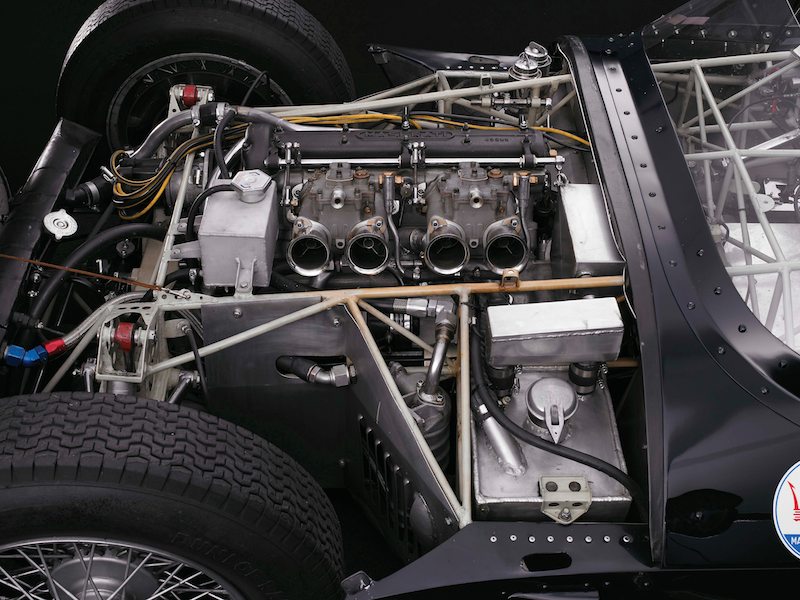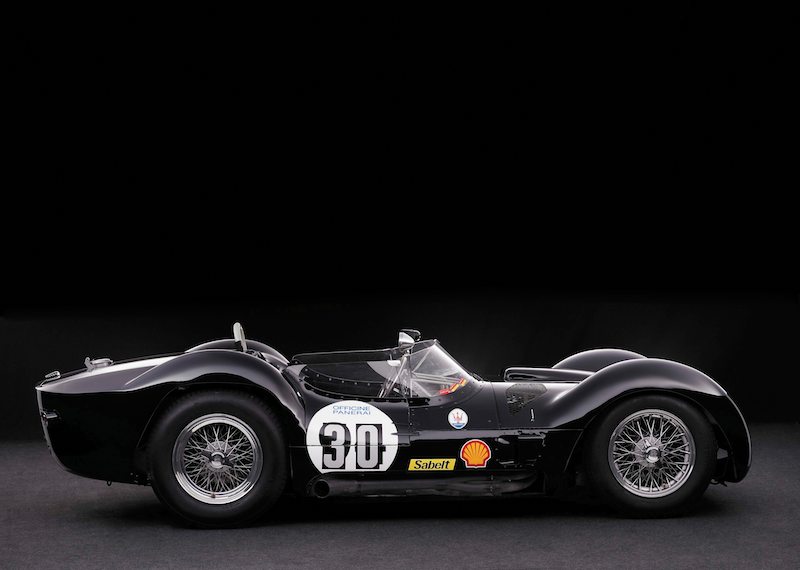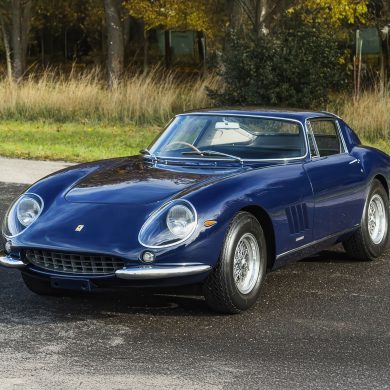Although Maserati had enjoyed competition success with its championship-winning 250F grand prix car, the Modenese company soon found itself in dire financial straits. With the introduction and sales success of the road-going 3500 GT, however, the company’s health improved drastically, prompting a renewed interest in creating a sports car that could be raced, not by the factory, but by privateers. Credit for the resulting Tipo 60/61 goes to engineer extraordinaire Giulio Alfieri who during 1958 created this stunning sports racing car. Its “Birdcage” nickname comes from its unique and very innovative trellis chassis construction, made of a plethora of small tubes between 10 and 15 mm thick. Once welded together (all 200 of them!), they created a structure as rigid as it was light, weighing just 36 kgs, clothed in svelte wheel-hugging aluminium body – a true work of art and testimony to Maserati craftsmanship!
Into this structure was fitted the Tipo 60’s 1,990 cc inline two-cam four-cylinder engine, very far back towards the cockpit. Independent front suspension provided superb turn-in while the de Dion rear axle with transverse leaf spring and coil over telescopic shock absorbers made the car easily controllable. In what would become Maserati’s last factory entry in decades, a Tipo 60 was entered at Rouen Les Essarts in July 1959, winning the race outright. Naturally, the phones started ringing off the hook in Modena!
Six Tipo 60s were sold before the 1961 upgrade to Tipo 61, which benefited from an increased capacity of 2,890 cc and delivered 250 hp – more than enough horsepower for a 600 kg heavy car. In all, 17 were built, including one Tipo 60 that had been upgraded. The car’s notable wins were the Camoradi team victories at the Nürburgring 1000 kms in 1960 and again in 1961, against the might of rival factory teams.
From the beginning, Birdcages were very popular with American competitors. The car offered here, chassis 2470, was no exception. The third-to-last Birdcage built, it was sold new in December 1960 to Jack Hinkle who was not just the proverbial wealthy amateur racer. A laid back, unassuming and popular Texas banker, oilman and then-president of the SCCA, he was described by historian Joe Scalzo as “one of the fastest men in competition today…He is in fact something all new – a wealthy sportsman driver who races as hard as the pros.” Scalzo went on to note that Hinkle was also a bit of an eccentric, having his lawn mower modified so it would run 50 mph…and promptly losing control and flattening his wife’s rose bushes!
The results he achieved with 2470 were stellar. In 1961 he entered seven races, of which he won three – La Junta, Colorado and two races in Oklahoma at Ponta City and Norman. He also had two second places finished, one third and just one DNF. The following year, he participated in nine more races, winning three (Nebraska, Oklahoma and Kansas), finishing second in three more, third in two races and again one DNF. Thus, he always finished on the podium, with the exception of the two races he did not finish.




Maserati Tipo 61 Birdcage – Car Profile Page Two
Hinkle eventually sold 2470 to a friend, Tracy Bird, who later became one of the founders of the Can-Am series. Bird raced it in Castle Rock, near Tucson, on 5th April 1964, finishing fifth. A fire in Bird’s garage did some damage to the front of the car, and to repair it properly, he bought the ex-Roger Penske Birdcage (chassis 2471) from its then-owner Enus Wilson. 2471’s rear end had suffered in an accident, but it had an intact front end. Bird thus repaired 2470 using the factory correct parts from 2471, after which its wreck was scrapped. As a result, 2470 is the second to last Birdcage extant, as 2472, the ex-Camoradi factory car now in the Panini Museum, is the only car with a higher chassis number.
Bird’s Maserati then crossed the Atlantic after its acquisition by F1 team owner and bon vivant Lord Alexander Hesketh. In his ownership, it competed with Charles Lucas (aka “Charlie Luke”) behind the wheel, who had previously raced a 250F. This was an era when vintage races were much more casual, cars arrived on flatbeds and starting grids were a patchwork of “run what ya brung.” On 20th May 1974, Lucas started on pole at the Silverstone Open Aston Martin Historic Race and was third for most of the event before retiring on the last lap.
He and Lord Hesketh recently shared some of their typically colourful memories with this writer:
Charles Lucas: “It was a great car to drive. I don’t think there were any old sports racing cars around that were quicker at the time – it even beat Robs Lamplough in his CanAm McLaren at Castle Combe. The best win was probably at the Historic support race for the Austrian GP at the Osterreichring in ’75. We had such a good lead, Alexander hung out a pit sign that said ‘Cocktails’, so we came in to the pits for a quick one!”
Needless to say this would not go down well nowadays! Lord Hesketh recalled the same event:
“I’d been advised by a friend who had a Tipo 61 to buy one as well so I did. It went to the Osterreichring in 1975. It was then a proper race track. We were disappointed in the GP – rather teed off, actually – and the only other race of the day was the vintage race but the trouble with that one is that it wasn’t really a race, it was meant to be a sort of 70 mph parade. Charles put in a lap at 130 mph. I mean at Zeltweg you’d expect to have a Type 61 unrestricted. This was going to get us into trouble, so we put out a pitboard that said “cocktails” in order to bring him in and slow him down. So he came in we gave him one, we let the whole of the field go by. Then he went out, overtook them all again and won the race. I think that is the only time we took it to a GP and raced it the same weekend.”
Later owners included Dieter Holterbosch of Oyster Bay, New York who had it restored and in 1998 sold it to Tony Smith in the U.K. The current owner acquired 2470 from Smith in 2004 and has used it in several Ferrari Historic Challenge Series events. The last Race entered was the 2009 Nürburgring Oldtimer Grand Prix, which the car won.
One of the most original Birdcages in existence, it is fitted with a spare race prepared engine. The original engine comes with the car, however. The body is mostly original. Maserati’s racing cars have steadily appreciated in value over the last 20 years as the marque’s rich and successful history gets more and more of the recognition it deserves. The Birdcage is one of the most iconic racers ever to come out of the hallowed Modenese factory. It is a tremendously competitive and enjoyable car to drive and a jewel of engineering.
This particular 1960 Maserati Tipo 61 Birdcage, chassis number 2470, sold for $3,343,648 at RM Auctions’ inaugural Sporting Classics of Monaco sale, held May 1st, 2010 at the Grimaldi Forum in Monaco.
Auction Editor Rick Carey reported on 2470:
The amalgamation of 2471’s nose with 2470’s tail and identity after a fire in Tracy Bird’s garage in 1964 toasted the original nose. Fitted with a new engine but supplied with the original. Head fairing noted by Oosthoek and Bollee as not original has been removed. Known history from new, restored in the 70’s for Lord Alexander Hesketh, historic raced recently and successfully. Nicely presented with good cosmetics in Jack Hinkle’s original black livery, a clean, well maintained historic race car with its FIA papers.
Not worth what a Camoradi car would bring, or one of the few surviving completely pure Tipo 60/61s, but a stunning, aggressive, correct and known history historic racer of unquestioned provenance and history that needs nothing at all to be competitive on the track and only an exhaustive detailing to make onlookers swoon at concours. This is what it took to own it, this is what it’s worth.
[Source: RM Auctions; photo credit: Michel Zumbrunn and Wilem Oosthoek Collection © Courtesy of RM Auctions]



















The RM description contains a couple of errors. Jack Hinkle was not from Texas but from Wichita, Kansas. Also, the car was never painted black during its competition years, as the color photos indicate.
Jacks Birdcage #61 was always Red!
Tracy Bird may have raced the car at Castle Rock, but Castle Rock is just south of Denver, Colorado, not Tucson, Arizona as stated.
Willem Oosthoek is right. Jack Hinkle was from Witchita, Kansas, where he was a banker. Also of interest is that 2470 was the 2nd Birdcage Hinkle raced. Earlier, his first Tipo 61 was seriously damaged in a race at the Oklahoma State Fairgrounds in Oklahoma City.
As Paul Garrett mentions, Hinkle hit a light pole at the narrow track at OKC in November 1960, but the car survived. Hinkle’s first Tipo 61 was repaired and he raced it one more time, at Malden Air Force Base in May 1961. Upon receiving his second Tipo 61, the first one was sold to George Koehne, who campaigned it into 1962.
Wonderful…